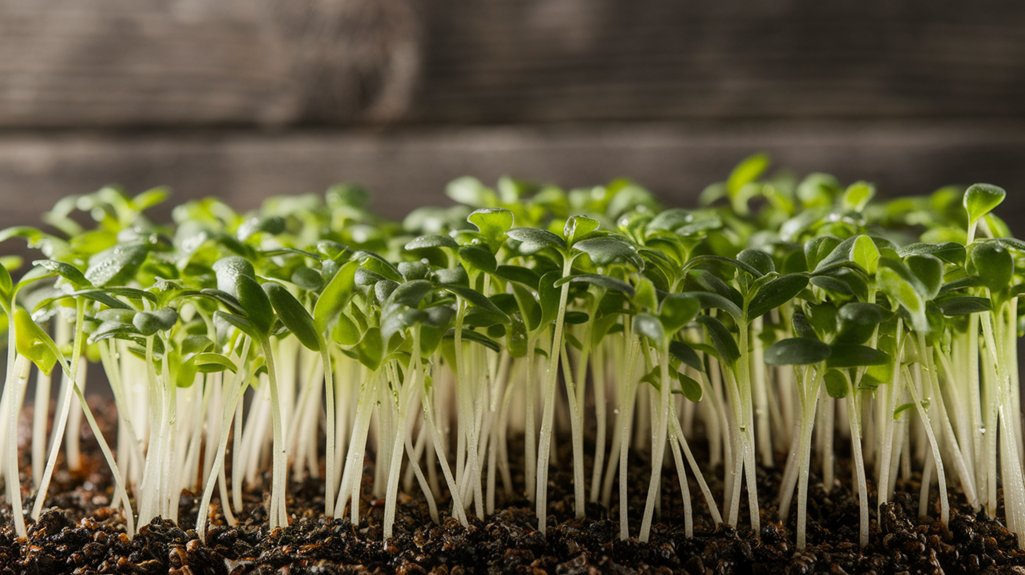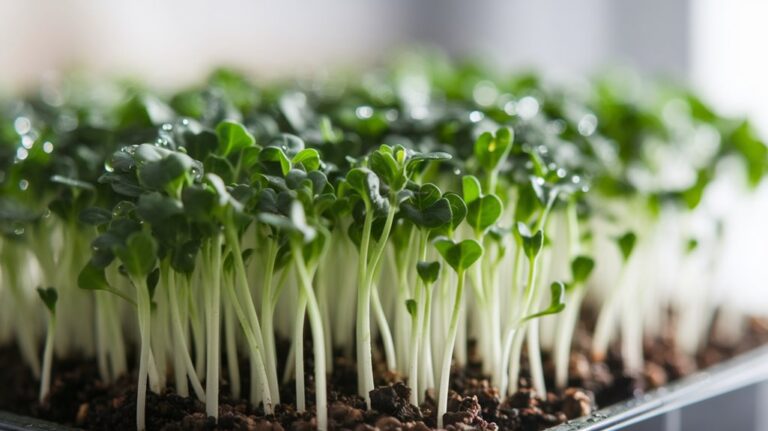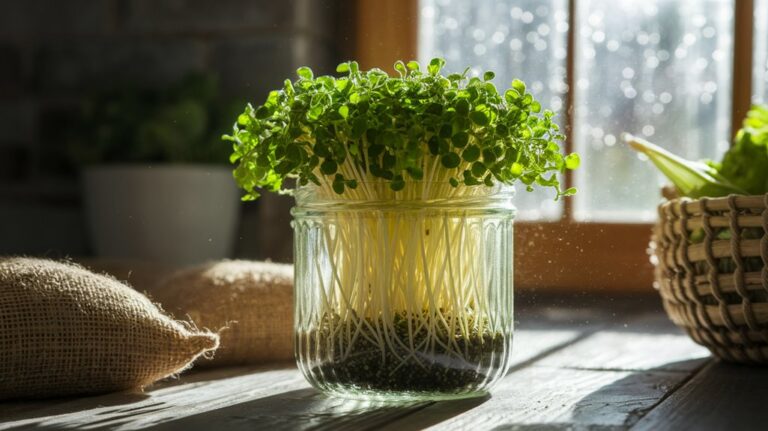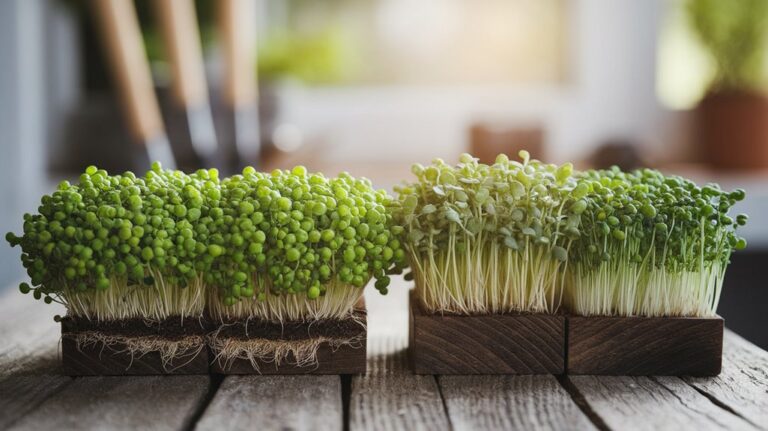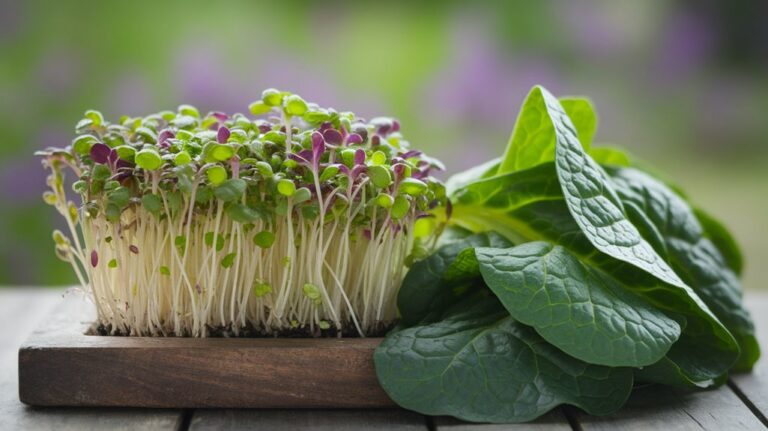The Ultimate Guide to Growing Sunflower Microgreens
To grow sunflower microgreens, I start with high-quality, organic black oil sunflower seeds for the best flavor and nutrition. I prepare a soil mix of 50% organic potting soil and 50% coconut coir, ensuring it’s well-draining yet moist. I maintain a warm environment with sufficient light for 12-16 hours daily. Watering daily while avoiding sogginess and harvesting at 2-4 inches in height ensures a healthy crop. There’s much more to explore, so let’s get started!
Key Takeaways
- Select high-quality black oil sunflower seeds with a high germination rate from reputable suppliers for optimal growth.
- Prepare a soil mix of 50% organic potting soil and 50% coconut coir for nutrient-rich, well-draining conditions.
- Maintain a warm environment of 70-75°F and provide 12-16 hours of bright, indirect light daily for healthy growth.
- Water daily to keep soil moist, using a spray bottle, and cover with a humidity dome initially to retain moisture.
- Harvest microgreens when they reach 2-4 inches and first true leaves, rinsing them gently for best flavor and presentation.
Selecting the Right Seeds for Sunflower Microgreens
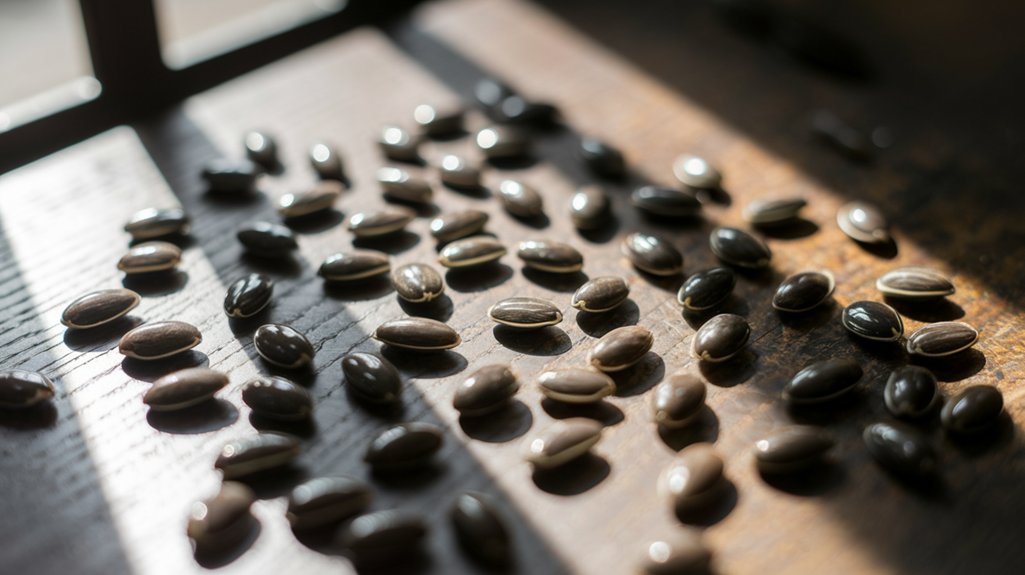
When I choose seeds for sunflower microgreens, I focus on quality and variety to ensure a successful harvest. High germination rates are crucial, so I always select seeds from reputable suppliers who provide germination tests.
I prefer organic seeds, which not only promote healthier growth but also contribute to a cleaner end product. Additionally, I consider the seed type; I often opt for black oil sunflower seeds due to their oil content and robust flavor profile.
It’s essential to check for any signs of damage or pests before purchasing. Lastly, I pay attention to the seed size, as smaller seeds can lead to denser growth. By prioritizing these factors, I’m setting myself up for a thriving microgreen crop.
Preparing the Ideal Soil Mix
Creating the perfect soil mix is essential for cultivating healthy sunflower microgreens. I recommend using a blend of 50% organic potting soil and 50% coconut coir. The potting soil provides essential nutrients, while the coconut coir enhances aeration and moisture retention.
Ensure the mix is well-draining; that’s crucial for preventing mold and root rot. To boost nutrient content, consider adding a tablespoon of worm castings per quart of soil. This enriches the mix naturally without chemical fertilizers.
Before planting, moisten the soil mixture thoroughly but avoid saturation. It should feel damp to the touch yet crumbly. This well-prepared soil mix serves as a solid foundation, allowing your sunflower microgreens to thrive and develop robust flavors.
Optimal Growing Conditions and Light Requirements
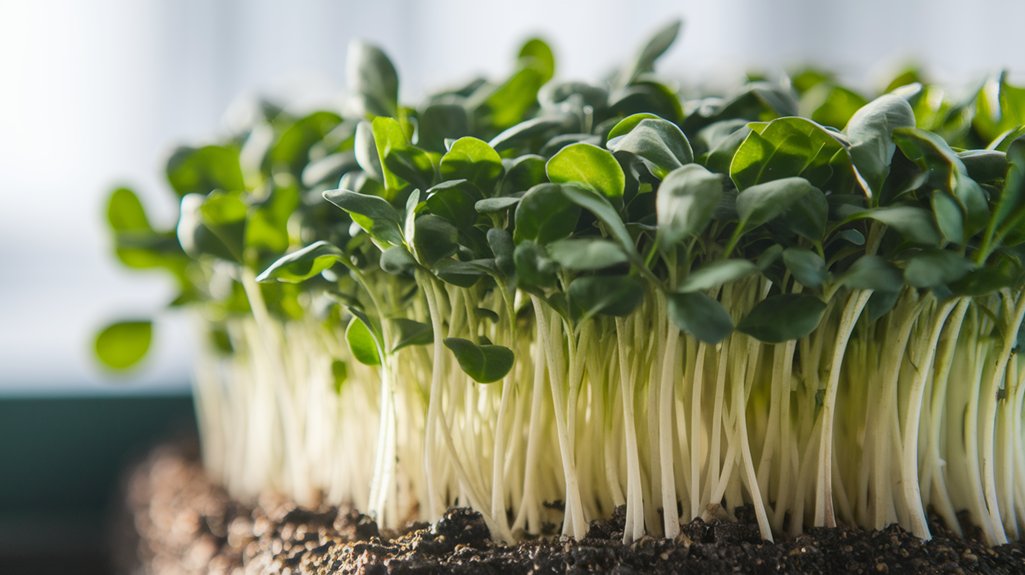
To ensure your sunflower microgreens flourish, it’s crucial to provide the right growing conditions and light. I find that a warm environment, ideally between 70-75°F (21-24°C), promotes optimal growth.
Adequate airflow is equally important, so I recommend using a growing tray with drainage holes to prevent mold.
When it comes to light, sunflower microgreens thrive under bright, indirect sunlight or with fluorescent grow lights. I usually place them about 2-4 inches away from the light source for 12-16 hours a day.
If you’re using natural light, a south-facing window works best. Just be cautious of excessive heat; too much direct sunlight can scorch the delicate leaves.
Proper conditions ensure vibrant, nutrient-rich microgreens ready for harvest!
Watering and Maintenance Tips
While proper watering is essential for the growth of sunflower microgreens, I’ve learned that maintaining the right moisture level is crucial to prevent issues like damping-off disease.
Here are some tips that have helped me keep my microgreens healthy:
- Water Frequency: I water daily, ensuring the soil remains consistently moist but not soggy.
- Watering Method: I use a spray bottle to gently mist the soil, preventing over-saturation and compaction.
- Humidity Management: Covering the tray with a humidity dome during the first few days retains moisture and encourages faster germination.
Harvesting and Enjoying Your Sunflower Microgreens
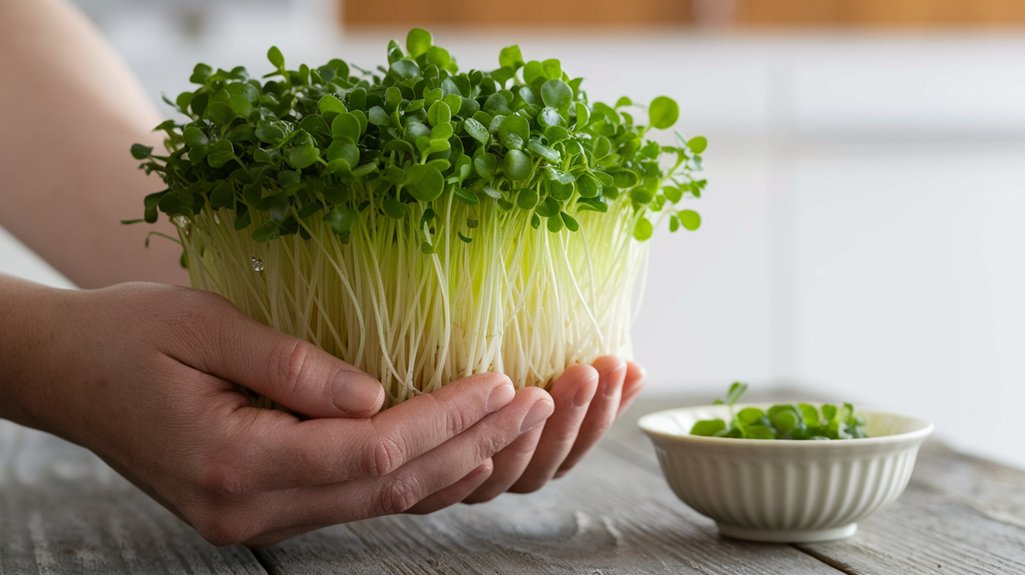
Once the sunflower microgreens reach about 2 to 4 inches in height and develop their first true leaves, it’s time for me to harvest them.
I use a clean, sharp pair of scissors to cut the microgreens just above the soil line, ensuring I don’t damage the roots. It’s best to harvest in the morning when they’re crisp and full of moisture, enhancing their flavor and nutrient content.
After cutting, I rinse them gently under cool water to remove any soil residue. I then pat them dry with a clean towel.
These microgreens are incredibly versatile; I enjoy adding them to salads, sandwiches, or as a garnish to elevate dishes. Their nutty flavor pairs wonderfully with various cuisines.
Frequently Asked Questions
Can I Grow Sunflower Microgreens Indoors Year-Round?
Absolutely, you can grow sunflower microgreens indoors year-round!
I’ve found that the key is providing consistent light, ideally using grow lights for about 12 to 16 hours daily.
Ensure your temperature stays between 70-75°F, and maintain moisture without over-watering.
I usually use a shallow tray with a quality growing medium.
How Long Do Sunflower Microgreens Typically Take to Germinate?
Sunflower microgreens typically take about 2 to 3 days to germinate.
I’ve found that keeping the seeds moist and in a warm environment helps speed up the process. During this time, I cover them with a damp cloth to maintain humidity, which really boosts germination rates.
Once they sprout, I uncover them and provide light. It’s fascinating to watch them grow quickly into vibrant, nutritious greens ready for harvesting!
What Pests Should I Watch for While Growing Sunflower Microgreens?
When growing sunflower microgreens, I keep an eye out for common pests like aphids, fungus gnats, and spider mites.
Aphids can cluster on the leaves, sucking sap and causing damage. Fungus gnats thrive in damp soil, while spider mites create webbing on the plants.
I’ve found that maintaining good airflow, proper watering practices, and using insecticidal soap helps manage these pests effectively.
Regular inspections ensure my microgreens stay healthy and pest-free.
Can I Reuse Soil After Harvesting Sunflower Microgreens?
Absolutely, you can reuse soil after harvesting sunflower microgreens, but there are a few things to keep in mind.
First, I recommend removing any leftover roots and debris.
Then, consider sterilizing the soil to eliminate potential pathogens.
I often mix in fresh compost or nutrients to replenish it, ensuring a healthy environment for the next crop.
Just remember, reusing soil can lead to nutrient depletion over time, so monitor its quality closely.
Are Sunflower Microgreens Safe for Pets to Consume?
Yes, sunflower microgreens are generally safe for pets to consume, but it’s always best to monitor them.
I’ve found that many pets enjoy the taste, and they can provide some nutritional benefits.
However, I’d avoid letting them eat too much at once, as it could upset their stomach.
Always consult your vet if you have concerns about introducing new foods to your pet’s diet, just to be on the safe side.
Conclusion
In conclusion, growing sunflower microgreens can be a rewarding experience that enhances both your culinary repertoire and health. By selecting quality seeds, preparing the right soil mix, and providing optimal light and water conditions, you can ensure a successful harvest. Remember to monitor your microgreens closely and enjoy them fresh in salads or as garnishes. With these tips, I’m confident you’ll master the art of cultivating sunflower microgreens in no time. Happy growing!

